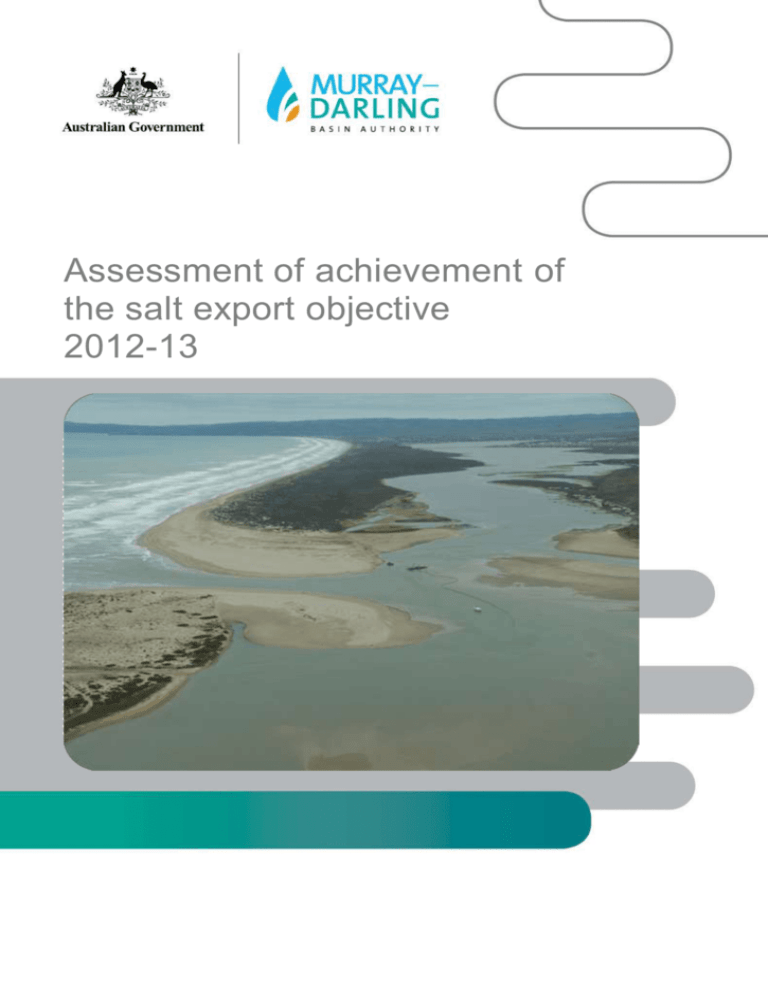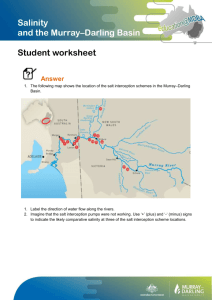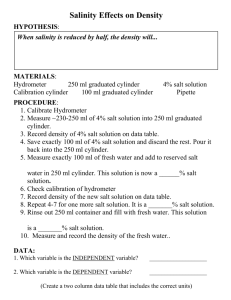Assessment of achievement of the salt export objective – 2012-13
advertisement

Assessment of achievement of the salt export objective 2012-13 Assessment of achievement of the salt export objective – 2012-13 The Murray–Darling Basin (Basin) sits within a naturally saline landscape. These landscapes are very old and salt has accumulated over millions of years due to deposits left by ancient oceans, natural weathering and salt brought by rainfall. This salt naturally moves through the landscapes and waterways of the Basin and some ultimately discharges to the ocean through the mouth of the River Murray. The export of salt through the River Murray to the ocean is essential for a healthy river system. The Basin Plan includes a salt export objective to ensure adequate flushing of salt from the River Murray System into the Southern Ocean. Each year the Murray–Darling Basin Authority must assess achievement of the salt export objective by comparing the estimated number of tonnes of salt exported per year averaged over the preceding 3 years against the indicative figure of 2 million tonnes per year. River regulation and consumptive water use, as well as the highly variable nature of the hydrological conditions in the Basin such as droughts and floods and complex groundwater systems, all have a significant impact on the amount of salt mobilised into the system and therefore available to be exported from the River Murray System. Accordingly, achievement of the salt export objective should be viewed in the wider context of overall salinity management and hydrological conditions in the Basin. What is important to understand is if there has been adequate flushing of the salt that is entering and moving through the river system to ensure that it is not threatening water quality in the Lower Murray. The Basin Plan also includes operational salinity targets which seek to limit the concentration of salt in the River Murray System to ensure that water is fit for a range of uses including for drinking, for the environment, for agriculture and for recreation (Table 1). While assessing adequate flushing of salt from the River Murray System we also need to consider salinity levels at the reporting sites to ensure that the Basin Plan operational salinity target values are also achieved while seeking to achieve the salt export objective. Table 1. Salinity levels at the reporting sites over the 5 year period from 1 July 2008 to 30 June 2013, compared to the target values (refer Basin Plan clause 9.14) Reporting site Salinity at 95% of the time (non-exceedance) (EC) (µS/cm)* Target value (EC) (µS/cm) River Murray at Murray Bridge River Murray at Morgan River Murray at Lock 6 Darling River downstream of Menindee Lakes at Burtundy Lower Lakes at Milang 735 597 350 613 830 800 580 830 5,685# 1,000 *Salinity levels compiled from best available data (daily mean values derived from continuously logged data). # Salinity at Milang increased markedly during the extended drought due to the low inflows and evapoconcentration effects. Lake Alexandrina water level returned to normal around October 2010 resulting in decreased Milang salinity. Over 2012–13, salinity at 95% of the time (non–exceedance) was about 590 EC. Page 1 Table 2. Summary of locations and salinity measurement variables used in the assessment of the salt export objective Variable Darling River at Burtundy salt load (tonnes/yr) River Murray at Euston salt load (tonnes/yr) River Murray at Lock 6 salt load (tonnes/yr) River Murray at Morgan salt load (tonnes/yr) River Murray at Murray Bridge salt load (tonnes/yr) Salt diverted away from the river through salt interception schemes (tonnes/yr) Estimated salt export at the barrages (tonnes/yr) – 3 year average is 2.9 million tonnes per year Annual average salinity (salt concentration) of Lake Alexandrina (EC – electrical conductivity) Flow over the barrages 2010-11 2011-12 0.6 million 1.3 million 2.2 million 2.7 million 0.6 million 0.7 million 1.3 million 1.6 million 2.8 million 1.8 million 0.324 million 0.363 million 5.1 million 2.2 million 1,395 EC 434 EC 12,713 GL 8,794 GL Figure 1. Salt loads at key locations in the Murray-Darling Basin The salt loads shown in Table 2 clearly demonstrate the movement of salt throughout the river system. Just under half of the salt in the river system passing by Morgan originated from the River Murray system above Euston, while the Darling River system contributed between 20% and 40% of the salt in the river system passing by Morgan. Salt loads continued to increase moving throughout the river system from the upstream sites (Burtundy and Euston) to the downstream sites in South Australia (Figure 1). Page 2 In years of lower flows, protection of the river system from salt accessions to maintain lower salinity or salt concentration is relatively more important compared to exporting salt out to the ocean. During these times salt interception schemes have an important role to play in diverting salt away from the river system. However, during periods of higher flow, such as have been experienced over the past three years, salt interception schemes play a lesser role in reducing river salt concentrations as there is greater dilution from the higher flows. The salt concentration of Lake Alexandrina showed a large reduction between 2010–11 and 2011–12 and this is reflected in the large difference in the quantity of salt estimated to have been exported over the barrages compared to the amount in the river system passing by Murray Bridge and entering the Lake Alexandrina. A large quantity of salt that had accumulated in Lake Alexandrina during the extended drought passed through the barrages with the higher flows in 2010–11. There was however a small increase in the salt concentration of Lake Alexandrina between 2011–12 and 2012–13 (Table 2). Higher flows throughout the River Murray system during the past three years resulted in salinity levels (expressed as a salt concentration not exceeded 95% of the time) over the last three year period at four of the five Basin Plan reporting sites being less than the prescribed target values. It is important to note that salinity levels at the reporting sites (Table 1) are determined over a five year period, whereas the salt export objective is assessed over a three year period. During the last three years the maximum observed salinity levels at Lock 6, Morgan and Murray Bridge did not exceed the target values at any time. The target value at Burtundy was exceeded only for three days over the last three years, while the Milang 3–year salinity level (95% of the time non-exceedance) of 3,889 EC (electrical conductivity) was almost four times greater than the target value of 1,000 EC. After Lake Alexandrina water levels returned to normal ranges in 2010–11, salinity levels at Milang decreased substantially and throughout 2012–13 the Milang 1–year salinity level (95% of the time non–exceedance) was 590 EC which is well below the target value. The results presented in Table 2 and illustrated in Figure 1 provide confidence that, as an average over the last three year period, the salt export objective to ensure adequate flushing has been achieved. Estimated salt export as an average over the last three year period (2010–11 to 2012–13) was about 2.9 million tonnes per year. This is greater than the figure of 2 million tonnes of salt export per year included in the Basin Plan which is expected to indicate achievement of the salt export objective. However, it must be noted that during the drought (2000–2010), average flow and salt export over the barrages per year were approximately 958 GL and just under 1 million tonnes of salt respectively. Furthermore, the results and discussion of salt export provided here in the broader context of overall salinity management and hydrological conditions in the Basin provides further evidence about adequate flushing of salt from the River Murray System and achievement of the salt export objective. Page 3








